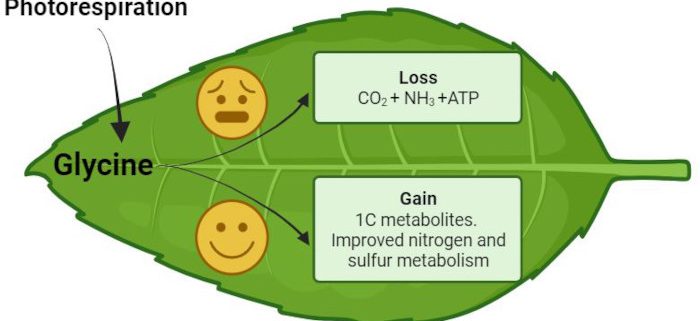Photorespiration: Wasteful or useful?
Rosa-Téllez et al. explore the role of glycine flux regulation by photorespiration in maintaining nitrogen, carbon, and sulfur balance in plants.
https://doi.org/10.1093/plcell/koad256
Sara Rosa-Téllez, Andrea Alcántara-Enguídanos and Roc Ros Palau.
Institut de Biotecnologia i Biomedicina (BIOTECMED). Departament de Biología Vegetal. Universitat de València. 46100 Burjassot, Spain.
Background: Photorespiration, in which Rubisco adds oxygen to ribulose 1,5-bisphosphate instead of adding carbon dioxide, thus lowering photosynthetic output, is a key metabolic pathway that will be affected by rising temperatures and increasing atmospheric CO2 levels. For a long time, this pathway has been considered a wasteful process that consumes energy in the form of ATP and reducing power. It also leads to the futile loss of carbon units as CO2, consequently constraining plant growth and yield. However, recent studies suggest that future climate conditions, which may reduce photorespiratory activity, may also enhance plant biomass albeit at the cost of decreased crop nutritional value.
Question: Should we consider photorespiration only as a loss-inducing process?
Findings: Our research reveals the crucial role of glycine flux regulation by photorespiration in maintaining nitrogen, carbon, and sulfur balance in plants. Redirecting glycine flux out of the photorespiratory pathway has a positive effect on plant nitrogen and sulfur levels. Our findings shed light on the molecular mechanisms through which reduced photorespiration adversely affects crop nutritional value. In mammals, the serine-glycine-one-carbon metabolic network functions as a central integrator of nutrient status. We propose a similar role for this network in plants.
Next steps: Our findings open new avenues for enhancing crop nutritional quality under future climate change conditions, particularly with regard to nitrogen content, an essential component of proteins and nucleic acids. Validating the feasibility of this biotechnological approach will require additional experiments conducted in natural environments across different species and under varying conditions of temperature, light, and CO2.
Reference:
Sara Rosa-Téllez, Andrea Alcántara-Enguídanos, Federico Martínez-Seidel, Ruben Casatejada-Anchel, Sompop Saeheng, Clayton L. Bailes, Alexander Erban, David Barbosa-Medeiros, Paula Alepúz, José Tomás Matus, Joachim Kopka, Jesús Muñoz-Bertomeu, Stephan Krueger, Sanja Roje, Alisdair R. Fernie, Roc Ros (2023) The serine-glycine-one carbon metabolic network orchestrates changes in nitrogen and sulfur metabolism and shapes plant development. https://doi.org/10.1093/plcell/koad256





